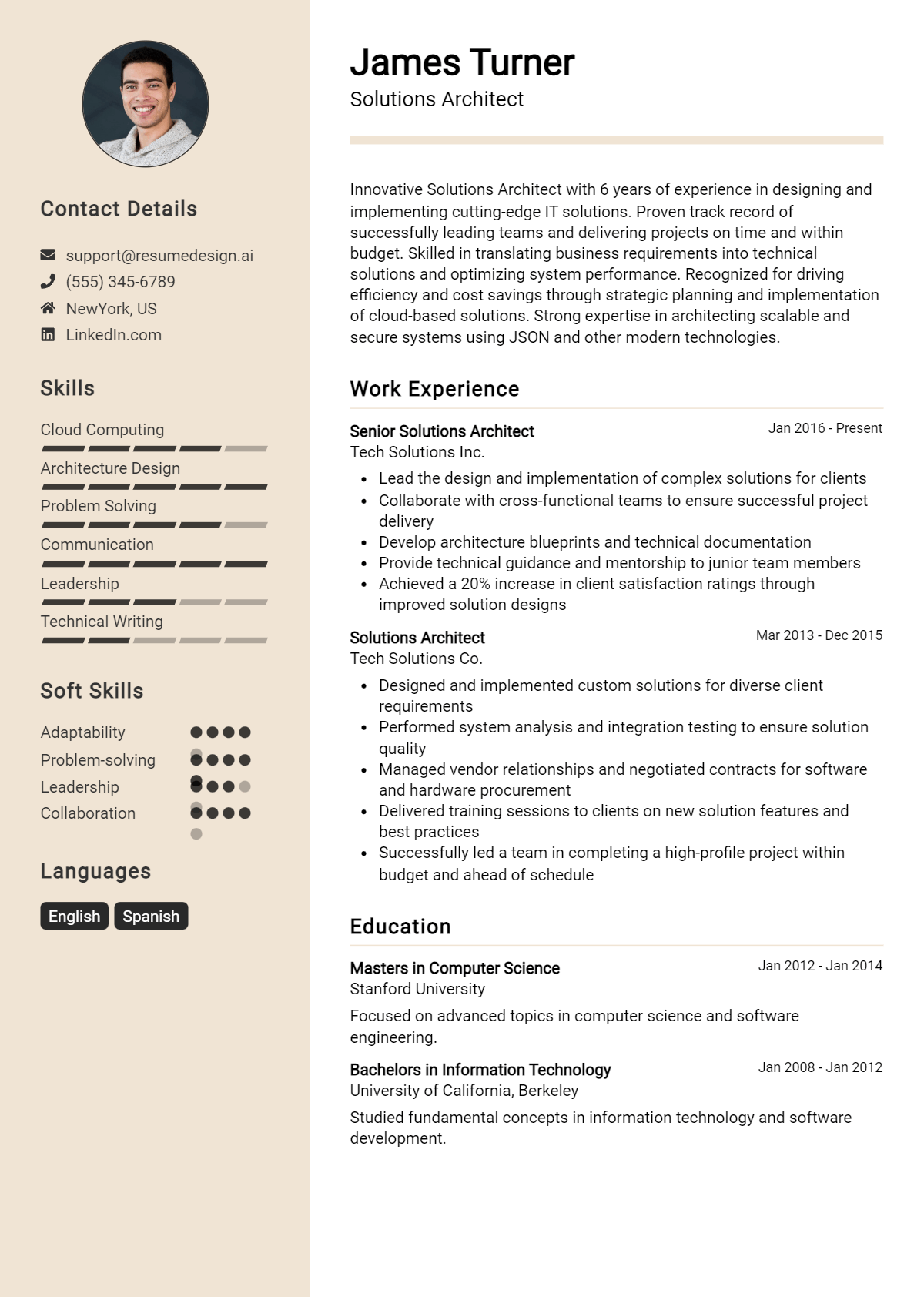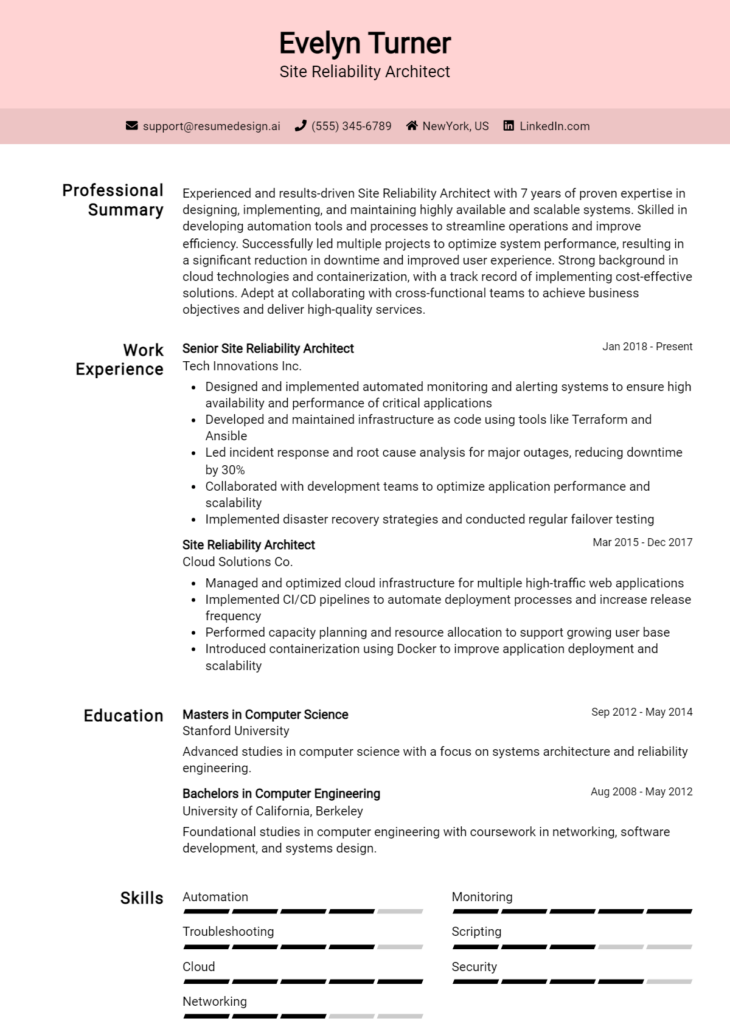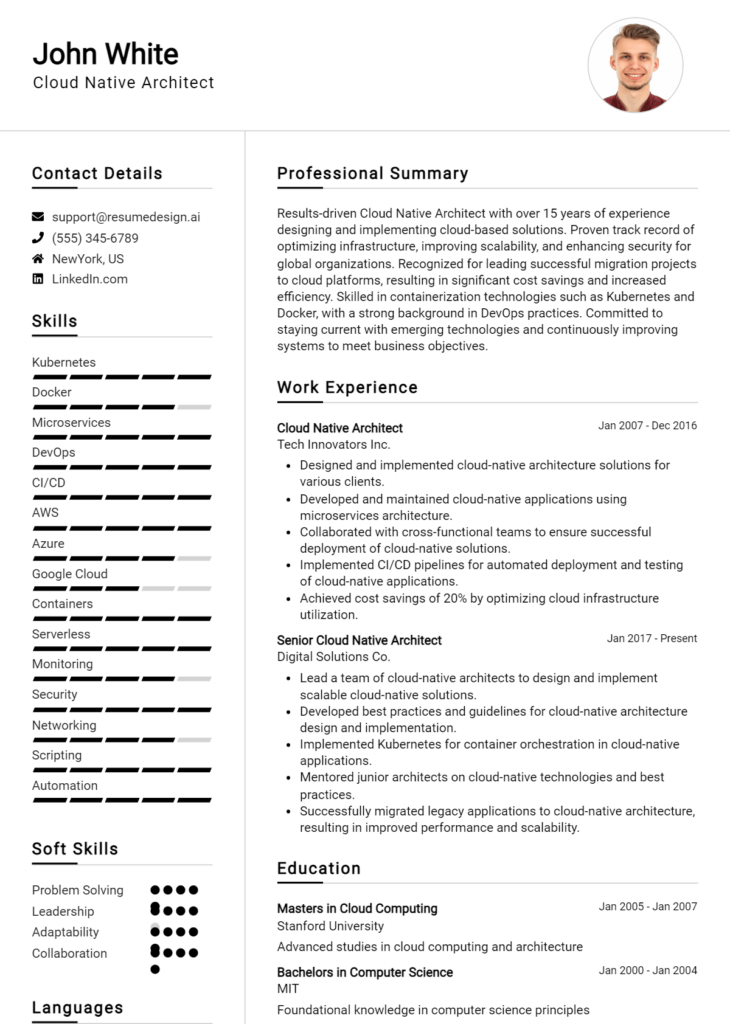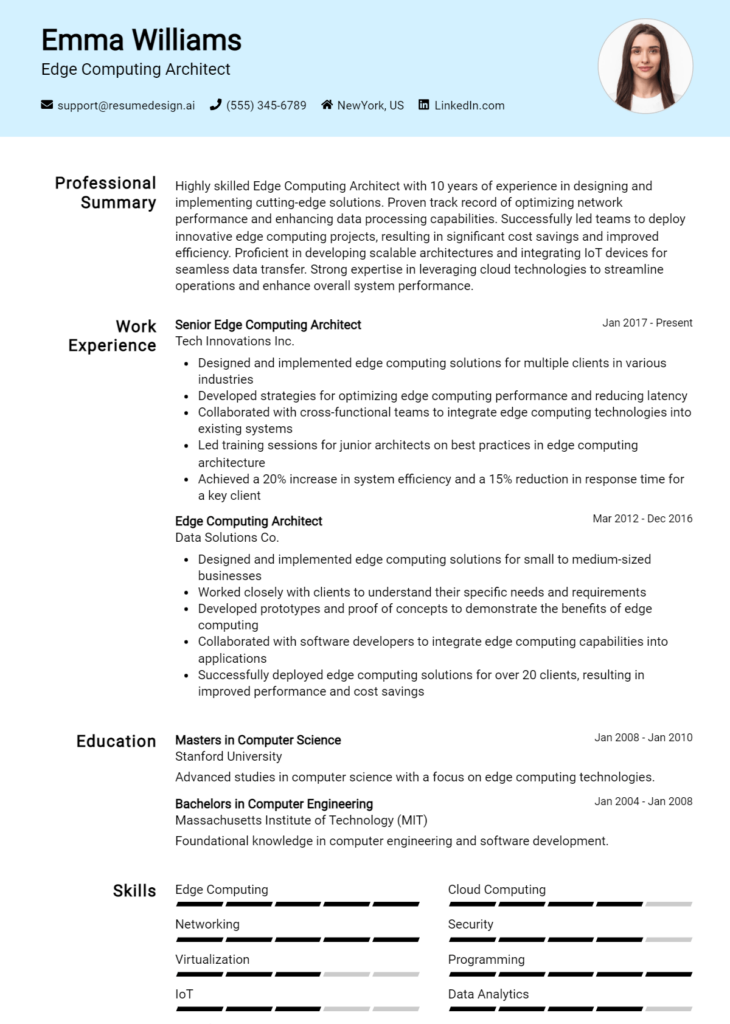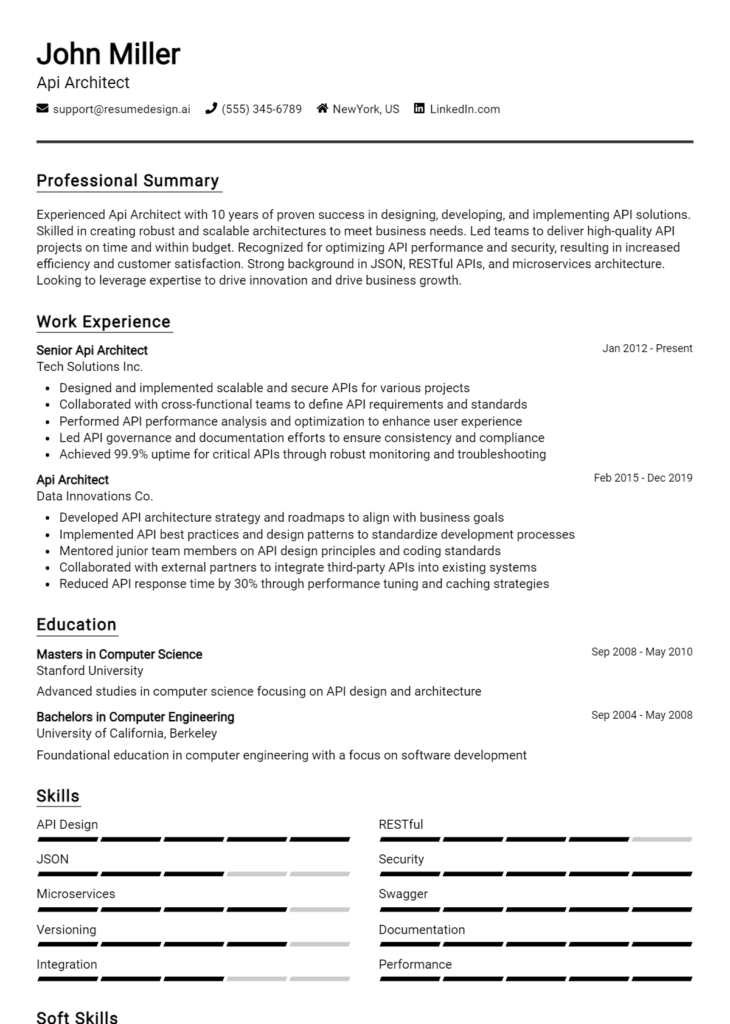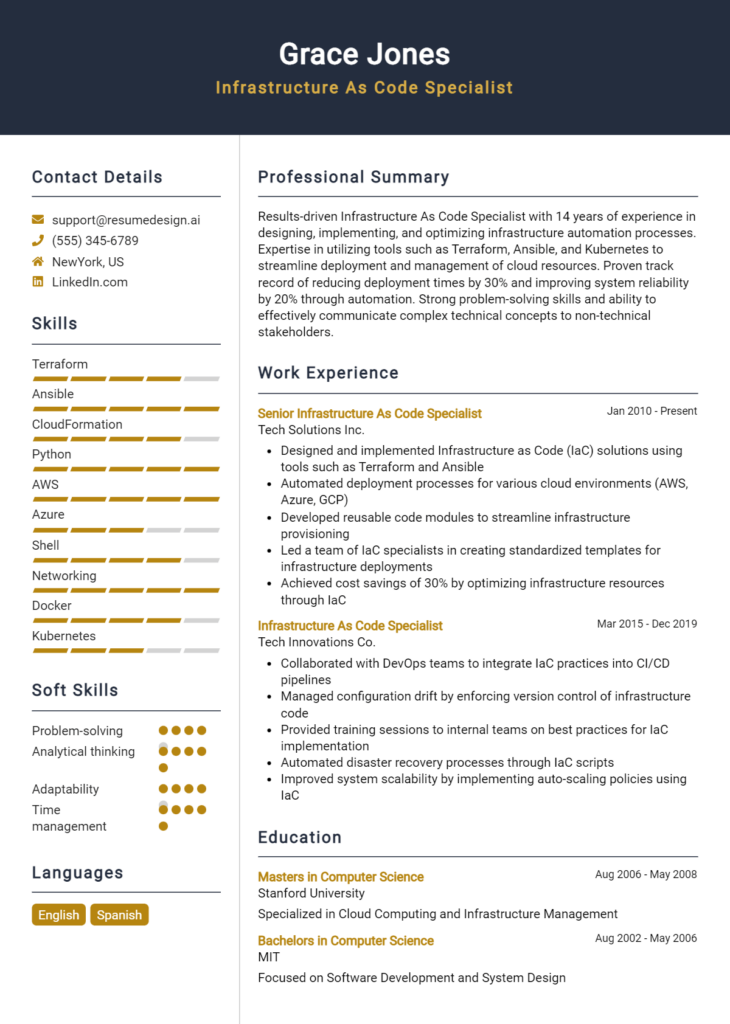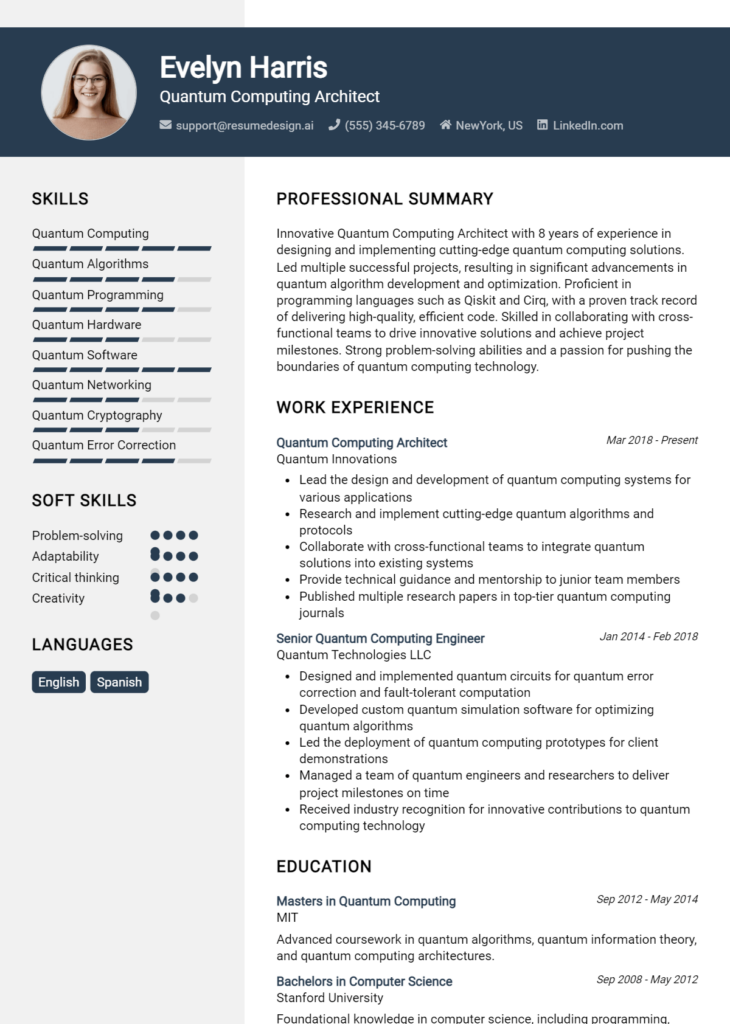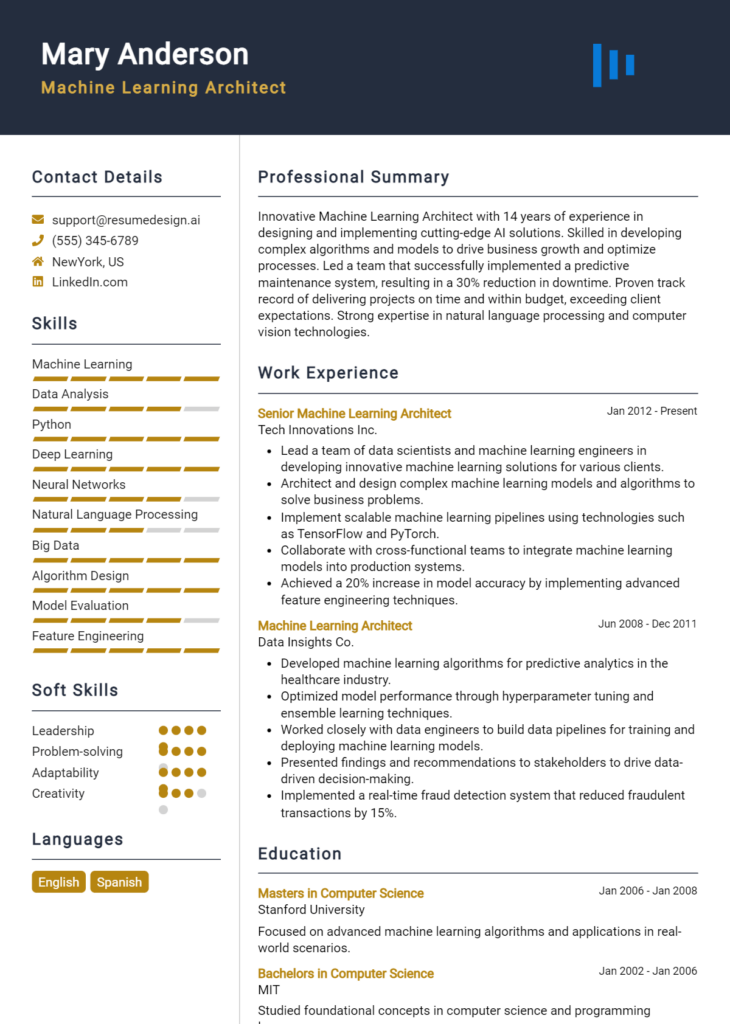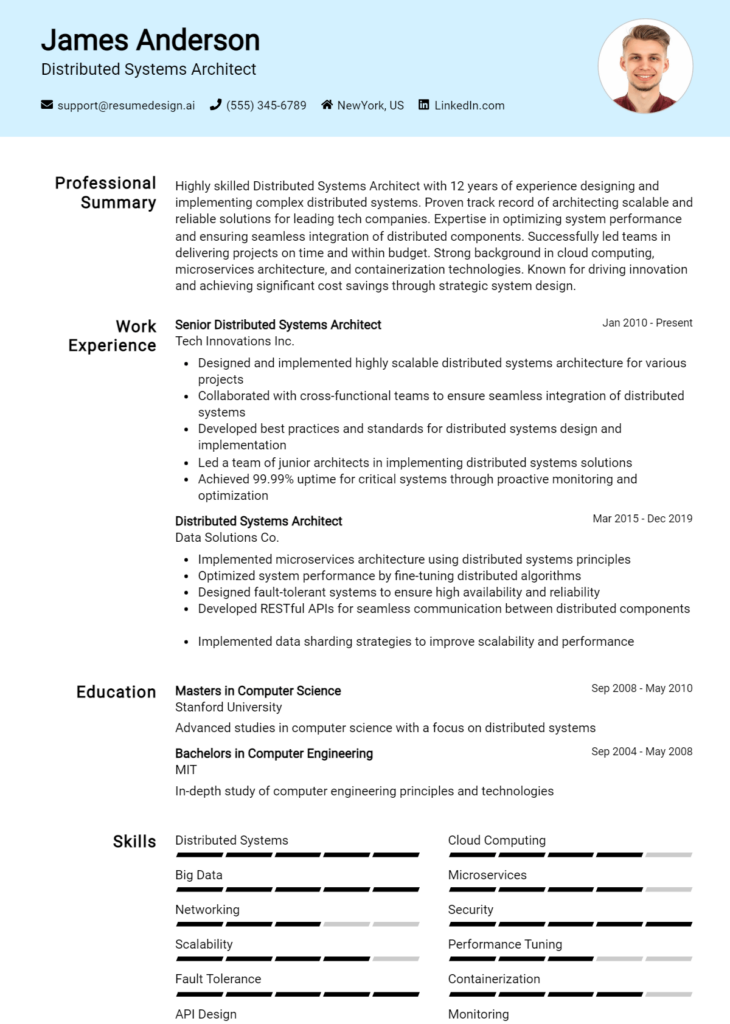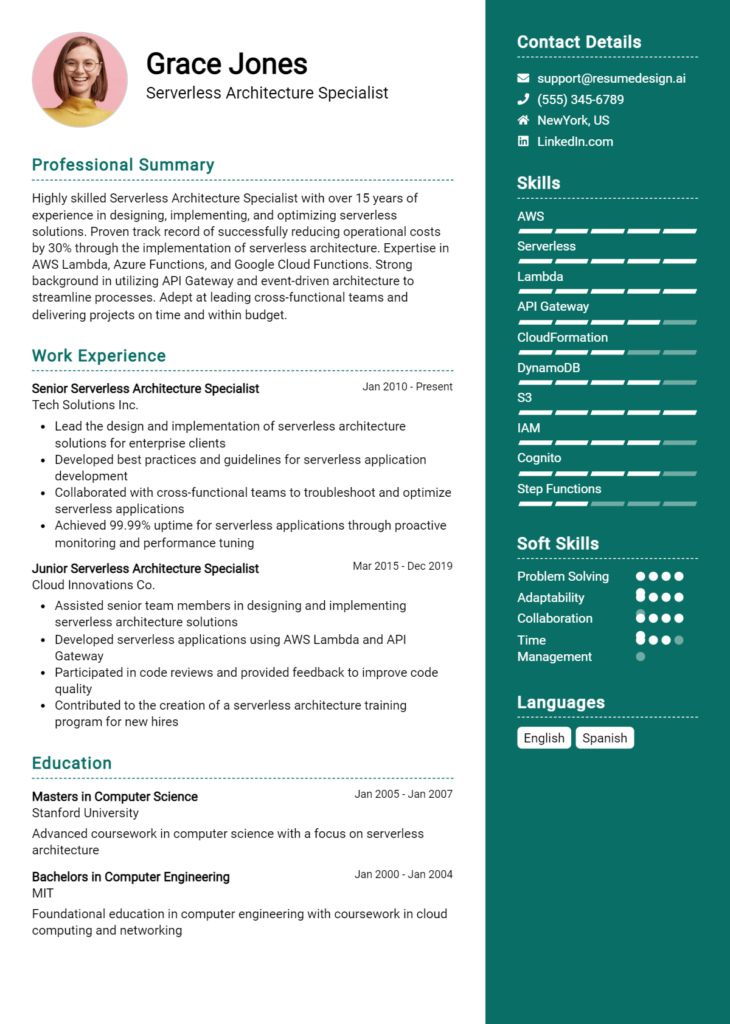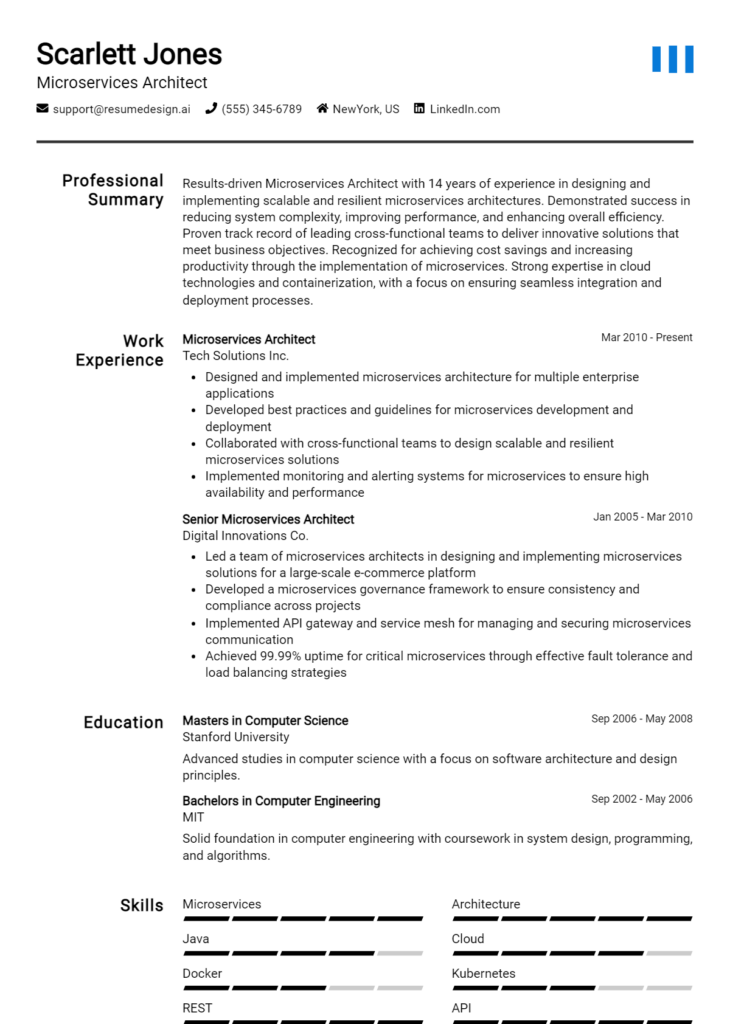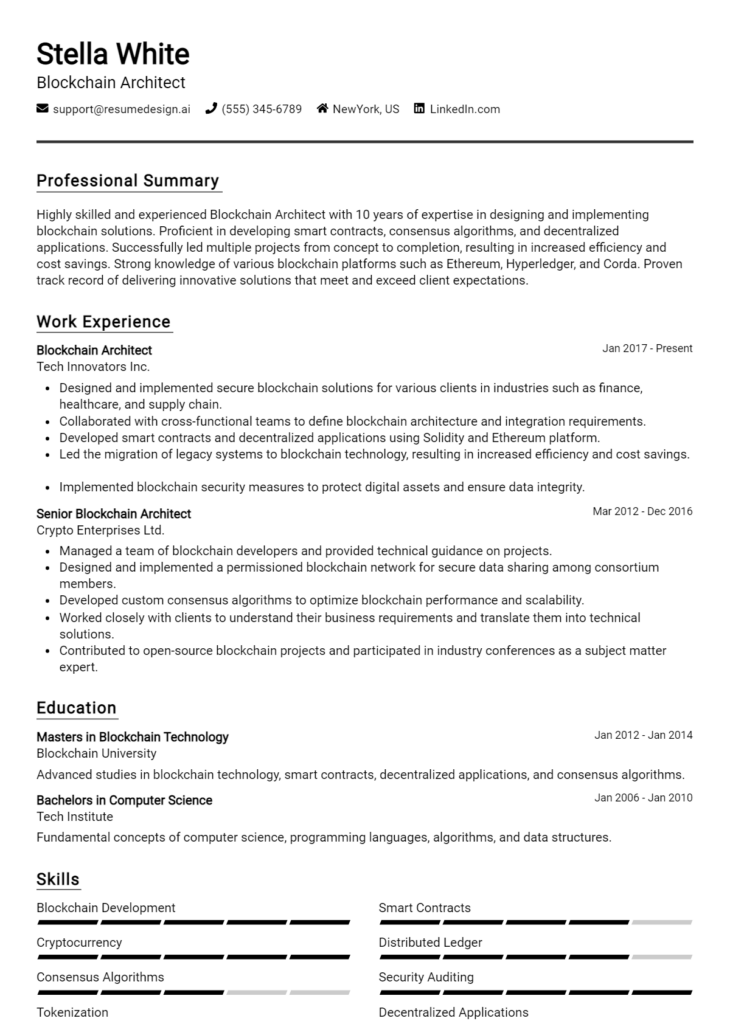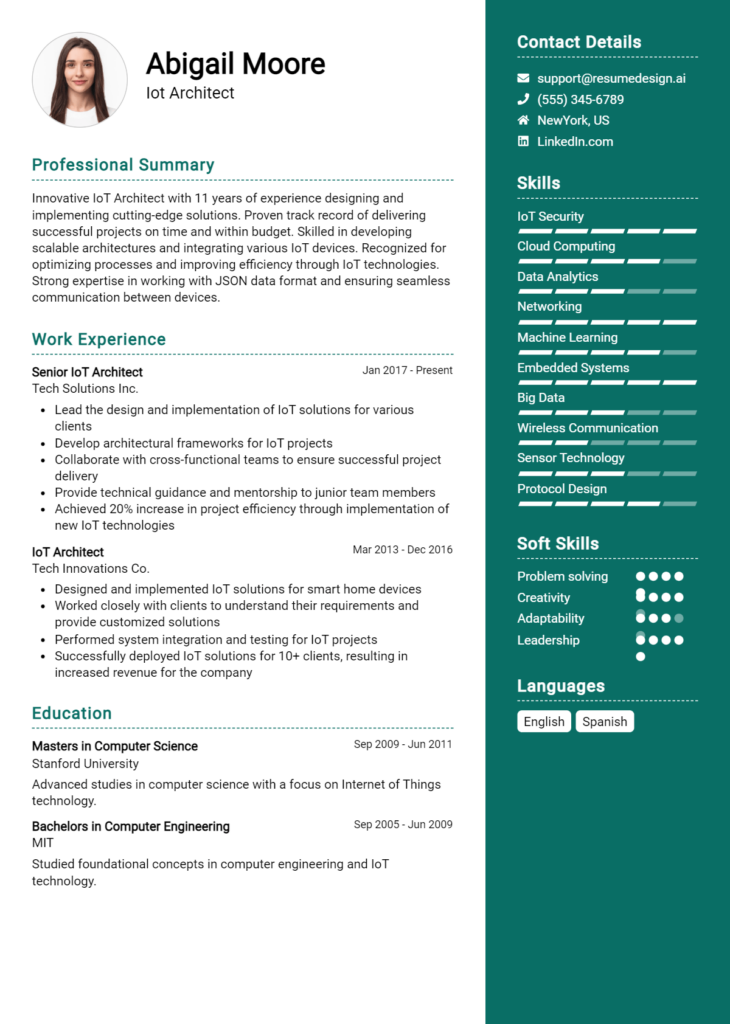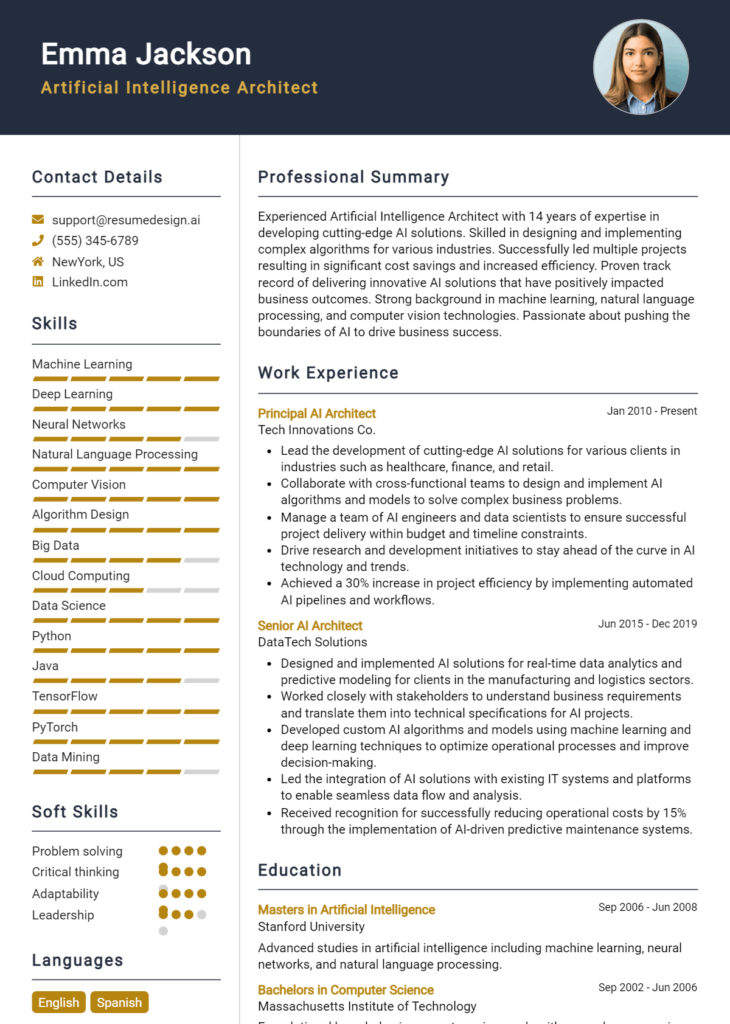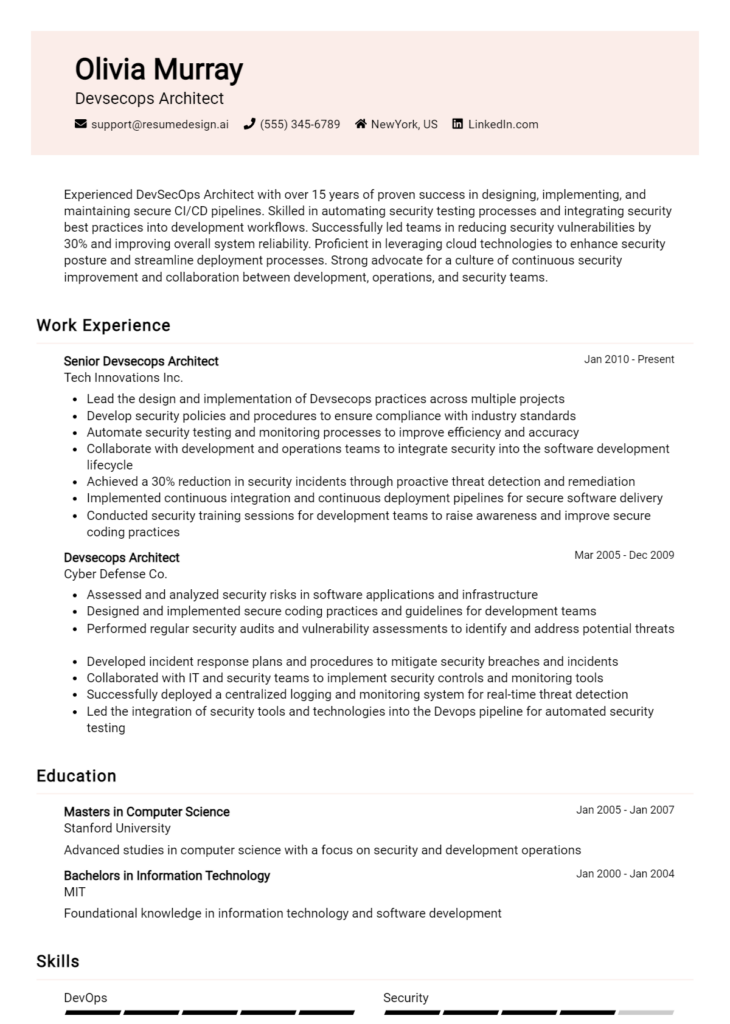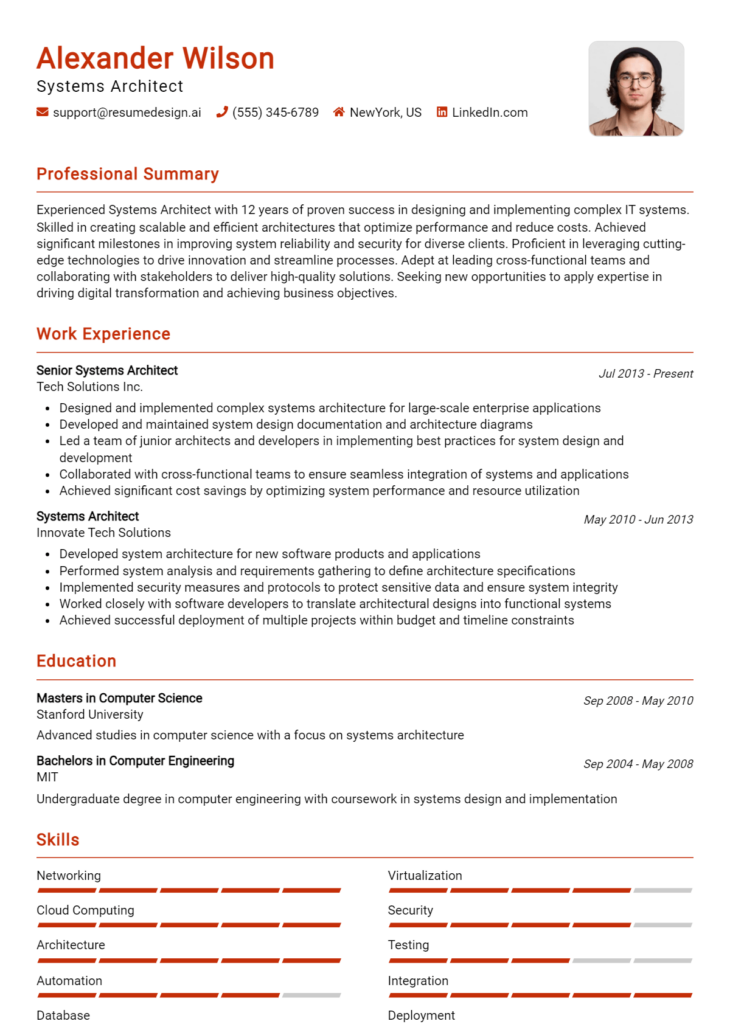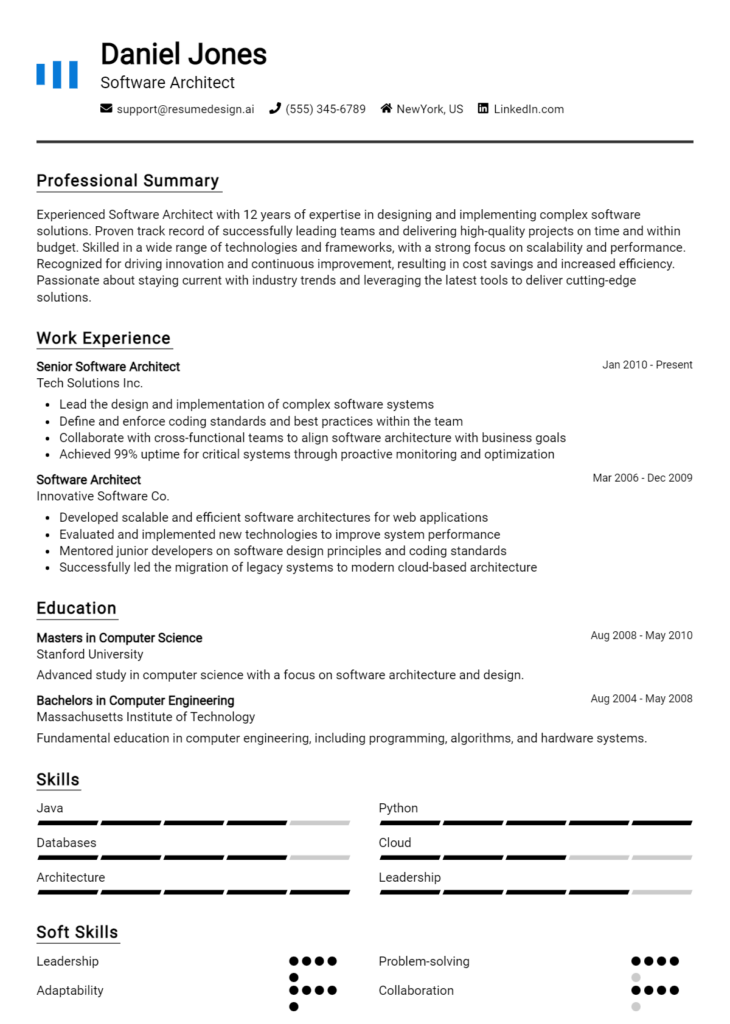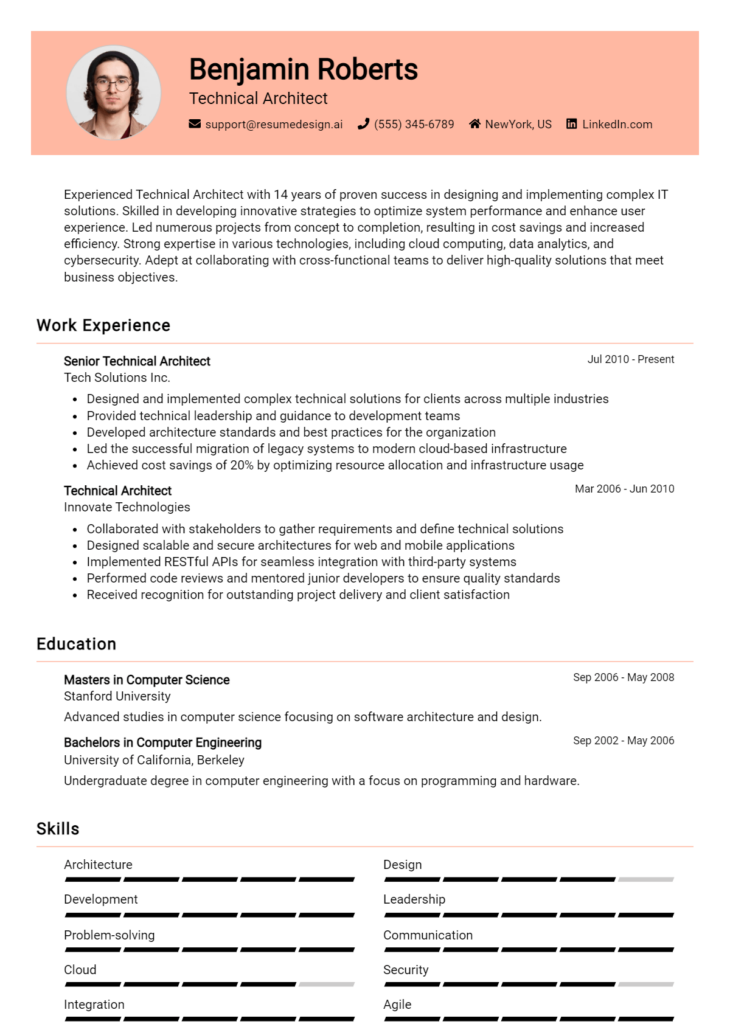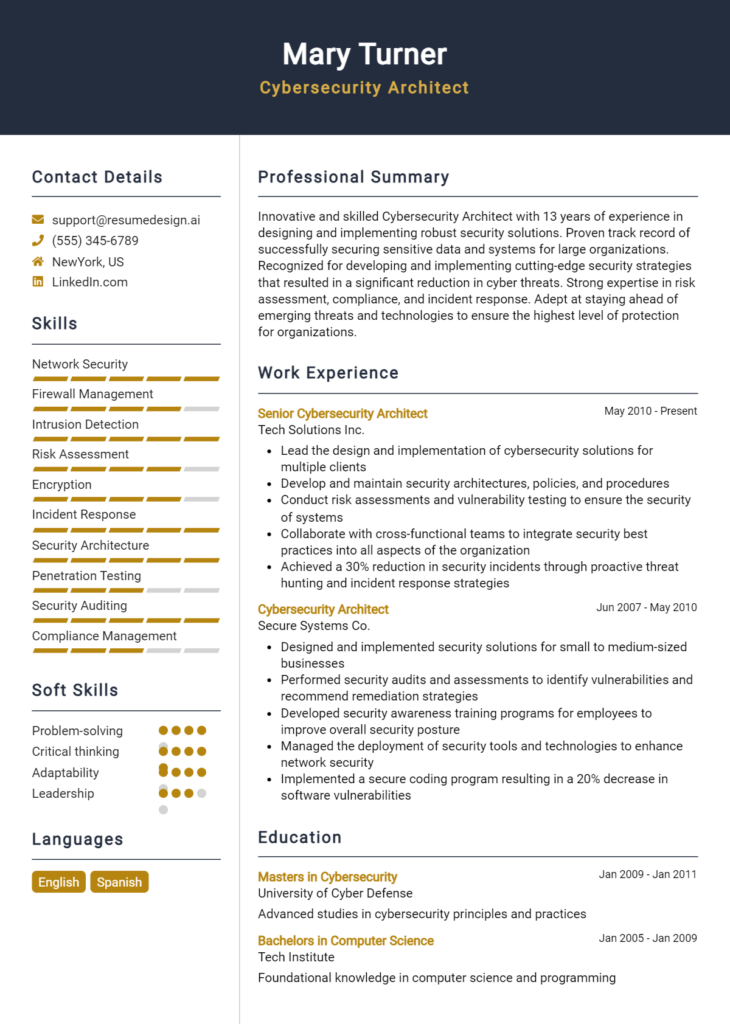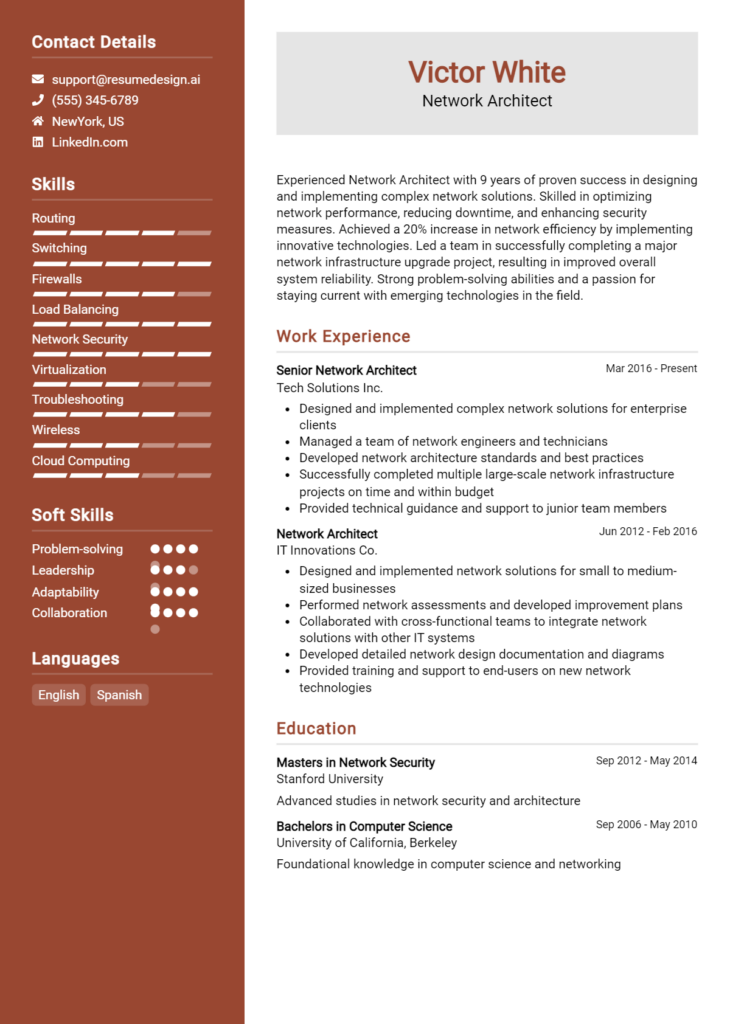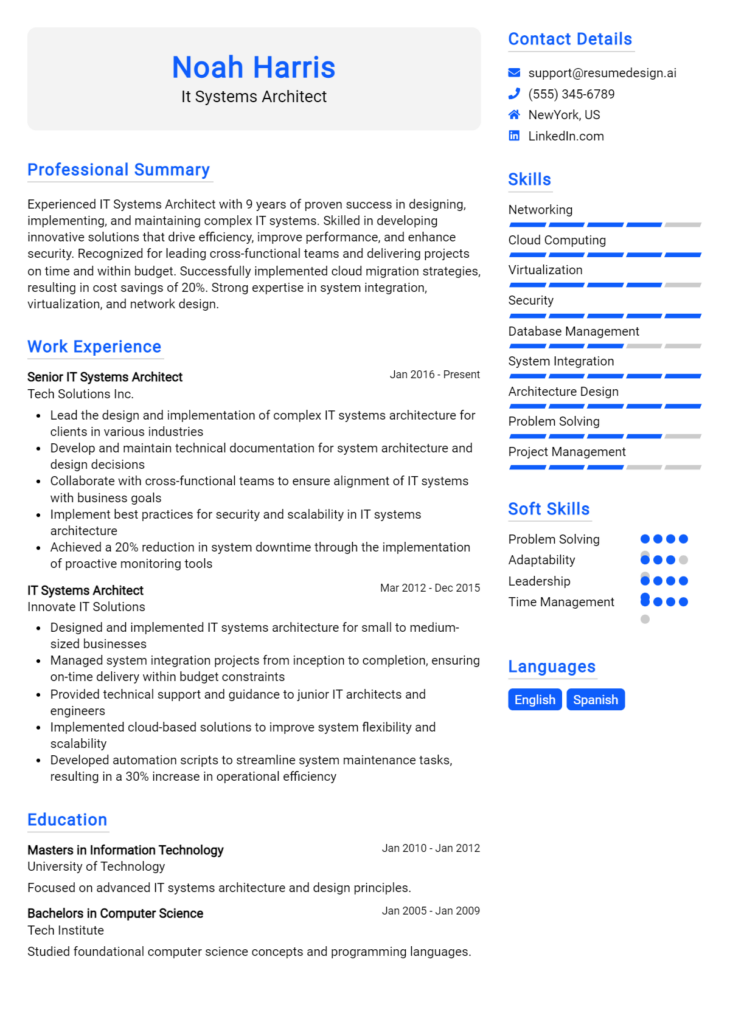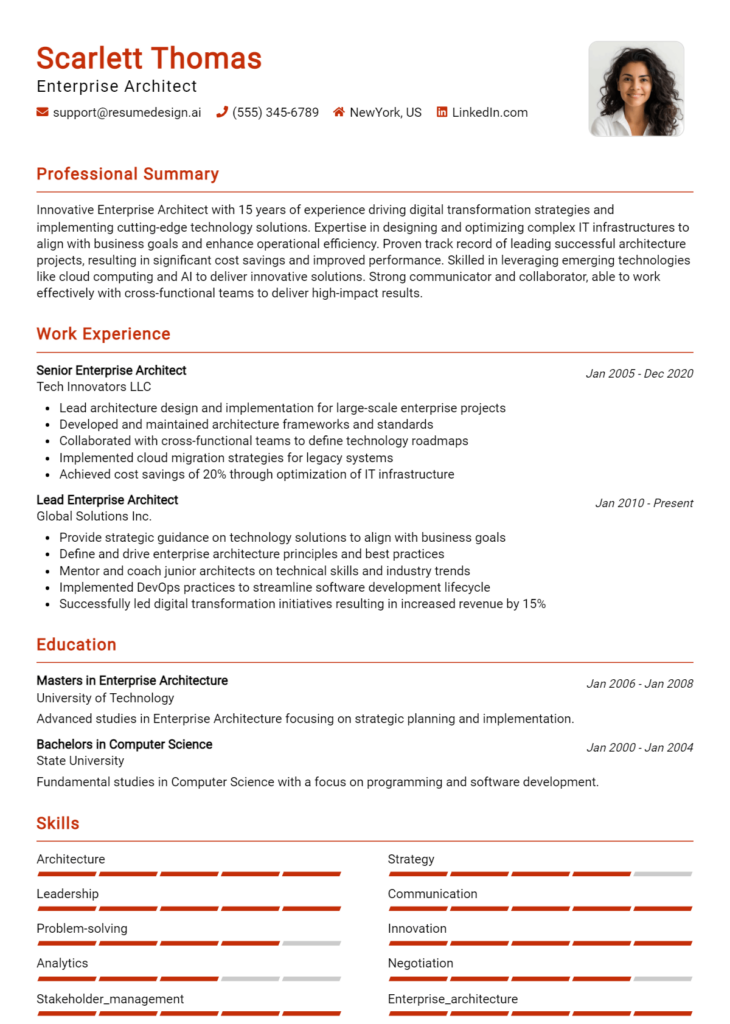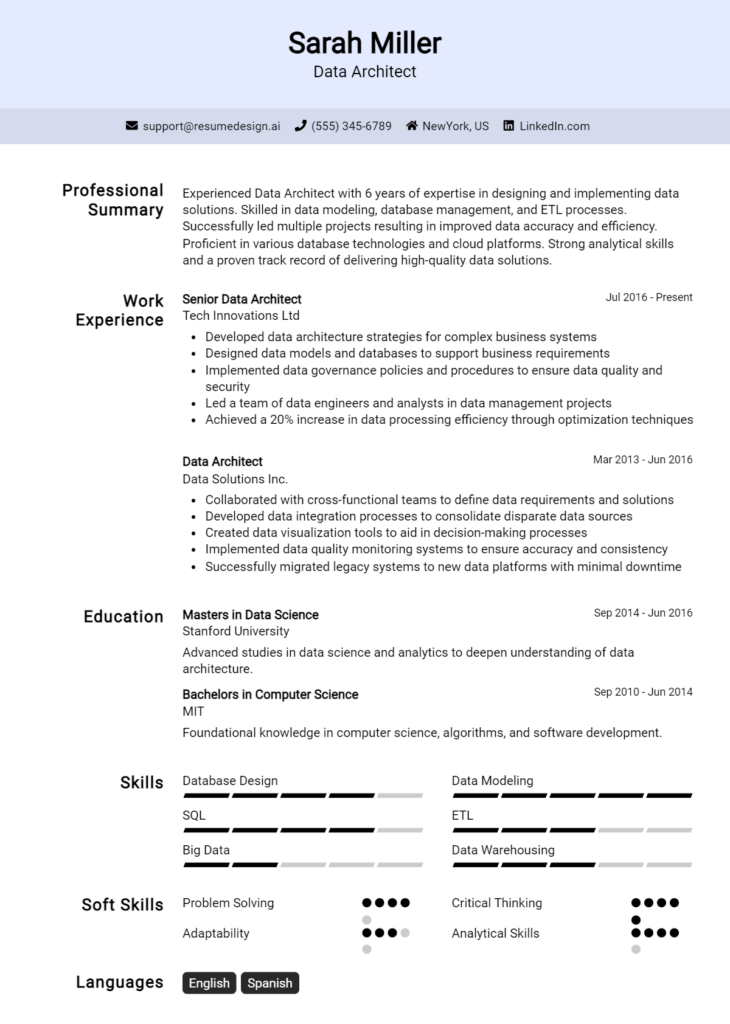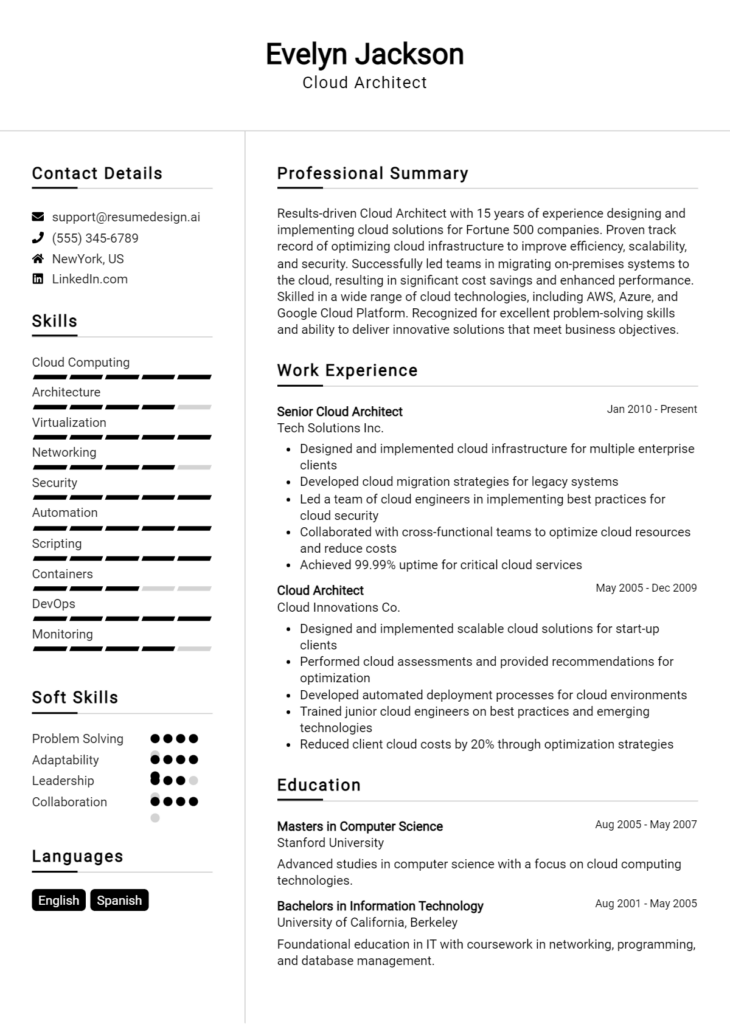Solutions Architect Core Responsibilities
A Solutions Architect plays a crucial role in bridging the gap between technical teams and business stakeholders. Key responsibilities include designing scalable systems, ensuring alignment with business goals, and facilitating communication across departments. Essential skills encompass technical expertise, operational understanding, and strong problem-solving abilities, all of which are vital for successful project execution. A well-structured resume that highlights these qualifications can significantly enhance an architect's candidacy, demonstrating their impact on organizational success.
Common Responsibilities Listed on Solutions Architect Resume
- Design and implement complex software solutions tailored to business needs.
- Collaborate with cross-functional teams to gather requirements and define project scope.
- Evaluate and recommend tools, technologies, and processes for software development.
- Ensure system architecture aligns with organizational goals and compliance standards.
- Develop and present architectural designs and technical documentation.
- Conduct risk assessments and propose mitigation strategies.
- Lead architectural reviews and provide technical guidance to teams.
- Stay updated on industry trends and emerging technologies.
- Facilitate training and mentorship for junior staff members.
- Monitor and improve system performance, scalability, and security.
- Communicate complex technical concepts to non-technical stakeholders.
- Participate in project planning, timelines, and budget discussions.
High-Level Resume Tips for Solutions Architect Professionals
In the competitive field of Solutions Architecture, a well-crafted resume is crucial for making a strong first impression on potential employers. Your resume serves as a marketing tool that highlights not just your technical skills but also your accomplishments and ability to deliver innovative solutions. It's essential that your resume reflects your unique expertise and demonstrates how your experiences align with the demands of the role. This guide will provide practical and actionable resume tips specifically tailored for Solutions Architect professionals, helping you to stand out in a crowded job market.
Top Resume Tips for Solutions Architect Professionals
- Tailor your resume to the specific job description, using relevant keywords that match the skills and qualifications sought by the employer.
- Showcase your relevant experience prominently, focusing on projects that demonstrate your ability to design and implement effective solutions.
- Quantify your achievements where possible, using metrics to illustrate your impact, such as cost savings, performance improvements, or project success rates.
- Highlight industry-specific skills such as cloud computing, database management, and system integration that are essential to the Solutions Architect role.
- Include certifications and training relevant to Solutions Architecture, such as AWS Certified Solutions Architect or TOGAF certification, to enhance credibility.
- Use a clear and professional format that makes your resume easy to read, ensuring that key information stands out.
- Incorporate a summary statement at the top of your resume that encapsulates your career highlights and core competencies in Solutions Architecture.
- Emphasize your soft skills, such as communication and collaboration, as these are critical for working with cross-functional teams and stakeholders.
- Keep your resume concise, ideally one to two pages, focusing on the most relevant and impactful information.
By implementing these tips, you can significantly increase your chances of landing a job in the Solutions Architect field. A polished resume that clearly articulates your skills, experiences, and achievements not only captures attention but also positions you as a strong candidate capable of delivering valuable solutions to prospective employers.
Why Resume Headlines & Titles are Important for Solutions Architect
In the competitive landscape of hiring for a Solutions Architect position, the importance of resume headlines and titles cannot be overstated. A well-crafted headline serves as the first impression a candidate makes on hiring managers, acting as a powerful summary of their key qualifications in one impactful phrase. It should be concise, relevant, and directly related to the specific job being applied for, effectively capturing attention and enticing recruiters to delve deeper into the resume. A strong headline can highlight specialized skills, significant experience, or notable achievements, setting the tone for the rest of the application and distinguishing the candidate from the competition.
Best Practices for Crafting Resume Headlines for Solutions Architect
- Keep it concise: Aim for a headline that is brief yet informative, ideally between 5 to 10 words.
- Be role-specific: Tailor the headline to reflect the specific Solutions Architect position you are applying for.
- Highlight key skills: Incorporate essential skills that are relevant to the job description.
- Use action-oriented language: Choose strong verbs and active voice to create a dynamic impression.
- Quantify achievements: If possible, include metrics or outcomes that demonstrate your impact in previous roles.
- Avoid jargon: Use clear and straightforward language to ensure your headline is easily understood.
- Reflect your expertise: Clearly convey your level of experience or any specialized knowledge you possess.
- Revise for relevance: Regularly update your headline to align with the evolving job market and specific job postings.
Example Resume Headlines for Solutions Architect
Strong Resume Headlines
Innovative Solutions Architect with 10+ Years in Cloud Integration
Results-Driven Solutions Architect Specializing in Enterprise Architecture
Award-Winning Solutions Architect with Proven Track Record in Agile Methodologies
Weak Resume Headlines
Solutions Architect
Experienced Professional in Technology
The strong headlines are effective because they concisely convey specific skills and accomplishments that directly align with the role of a Solutions Architect, making it clear why the candidate would be a valuable asset. In contrast, the weak headlines fail to impress due to their vagueness and lack of detail, offering no insight into the candidate’s qualifications or suitability for the position. By avoiding generic titles, candidates can better position themselves in the eyes of hiring managers and increase their chances of being selected for interviews.
Writing an Exceptional Solutions Architect Resume Summary
A resume summary is a critical component for a Solutions Architect, serving as the first impression for hiring managers. It quickly captures their attention by showcasing your key skills, rich experience, and significant accomplishments that are directly relevant to the role. A well-crafted summary should be concise, impactful, and tailored to the specific job you're applying for, ensuring that it resonates with the employer’s needs and effectively highlights your qualifications in a competitive job market.
Best Practices for Writing a Solutions Architect Resume Summary
- Quantify Achievements: Use numbers and metrics to showcase your successes and impact in previous roles.
- Focus on Skills: Highlight specific technical skills and competencies that align with the job description.
- Tailor the Summary: Customize your summary for each application to reflect the requirements and responsibilities outlined in the job posting.
- Be Concise: Keep your summary to 2-4 sentences, making every word count.
- Use Action Words: Start sentences with strong action verbs to convey confidence and proactivity.
- Showcase Relevant Experience: Emphasize your experience in designing solutions and working with stakeholders.
- Highlight Soft Skills: Include interpersonal skills that are crucial for collaboration and communication within teams.
- Convey Passion: Express enthusiasm for technology and solutions architecture to demonstrate your commitment to the field.
Example Solutions Architect Resume Summaries
Strong Resume Summaries
Dynamic Solutions Architect with over 8 years of experience in designing scalable cloud solutions that improved system performance by 30% and reduced costs by 20%. Proficient in AWS and Azure, with a strong background in agile methodologies and cross-functional team collaboration.
Results-driven Solutions Architect with a proven track record of implementing enterprise-level solutions, leading to a 50% increase in operational efficiency. Expertise in microservices architecture and API management, complemented by exceptional communication skills and stakeholder engagement.
Innovative Solutions Architect skilled in translating complex business requirements into technical solutions. Successfully led a project that migrated legacy systems to cloud infrastructure, resulting in a 40% reduction in downtime and a significant boost in user satisfaction.
Weak Resume Summaries
Experienced IT professional looking for a Solutions Architect role. I have worked on various projects and have some knowledge of cloud technologies.
Solutions Architect with experience in designing systems. I am a team player and can work well with clients and colleagues.
The strong resume summaries are effective because they include specific achievements, quantify results, and highlight relevant skills, making the candidates stand out in the hiring process. In contrast, the weak summaries lack detail and specificity, failing to convey the candidates' unique value propositions or their direct relevance to the Solutions Architect role.
Work Experience Section for Solutions Architect Resume
The work experience section of a Solutions Architect resume is critical as it not only highlights the candidate's technical skills but also illustrates their capability to lead teams and deliver high-quality products. This section provides concrete evidence of the candidate's expertise in designing and implementing complex solutions, managing cross-functional teams, and achieving project goals. By quantifying achievements and aligning past experiences with industry standards, candidates can effectively demonstrate their value to potential employers, showcasing their ability to drive innovation and success within an organization.
Best Practices for Solutions Architect Work Experience
- Highlight relevant technical skills, including specific technologies, frameworks, and methodologies used.
- Quantify achievements with metrics, such as percentage improvements, cost savings, or project timelines.
- Focus on collaborative projects that demonstrate teamwork and leadership capabilities.
- Use action verbs to convey a sense of responsibility and initiative, such as "designed," "led," or "implemented."
- Align your experiences with industry standards and best practices to show familiarity with current trends.
- Include specific examples of problem-solving and innovation that led to successful outcomes.
- Tailor your experience to the job description, emphasizing relevant projects and skills.
- Keep descriptions concise and impactful, making sure each bullet point adds value to your resume.
Example Work Experiences for Solutions Architect
Strong Experiences
- Led the migration of a legacy system to a cloud-based solution, resulting in a 30% reduction in operational costs and improved scalability for 200+ users.
- Designed and implemented a microservices architecture that increased deployment frequency by 50%, enhancing the overall product delivery cycle.
- Collaborated with cross-functional teams to develop a data analytics platform, improving decision-making speed by 40% through real-time insights.
- Managed a team of 10 developers, successfully delivering a multi-tier application ahead of schedule, which resulted in a 20% increase in customer satisfaction ratings.
Weak Experiences
- Worked on various projects in different technologies without specifying any outcomes or responsibilities.
- Participated in team meetings and discussions related to solution designs but did not contribute significantly.
- Assisted in the development of applications without detailing the role or impact on the project.
- Involved in multiple projects over several years without highlighting any measurable results or achievements.
The examples provided illustrate the distinction between strong and weak experiences. Strong experiences are characterized by clear, quantifiable outcomes, demonstrating a direct impact on the organization and showcasing technical leadership and collaboration. In contrast, weak experiences lack specificity, measurable results, and do not effectively convey the candidate's role or contributions, making it difficult for potential employers to assess their value.
Education and Certifications Section for Solutions Architect Resume
The education and certifications section of a Solutions Architect resume plays a critical role in showcasing a candidate's academic background and industry-relevant qualifications. This section serves as a testament to the candidate's commitment to continuous learning and professional development, essential traits for a role that demands both technical expertise and innovative problem-solving abilities. By detailing relevant coursework, certifications, and specialized training, candidates can significantly enhance their credibility and demonstrate their alignment with the responsibilities and expectations of the Solutions Architect position.
Best Practices for Solutions Architect Education and Certifications
- Focus on relevance: Include degrees and certifications directly related to architecture, cloud computing, and software development.
- Detail advanced credentials: Highlight any advanced degrees or specialized certifications that set you apart from other candidates.
- Include industry-recognized certifications: List certifications from reputable organizations, like AWS, Azure, or Google Cloud, that are well-respected in the industry.
- Be specific about coursework: Mention specific courses that are relevant to architecture and design principles to showcase your foundational knowledge.
- Update regularly: Ensure that the section reflects your most current qualifications and any new certifications obtained.
- Use clear formatting: Present information in a clean and organized manner to enhance readability and professionalism.
- Tailor to the job: Adjust the content of this section based on the job description to better match the employer's requirements.
- Highlight continuous learning: Include any ongoing education or training programs to demonstrate your commitment to staying up-to-date with industry trends.
Example Education and Certifications for Solutions Architect
Strong Examples
- M.S. in Computer Science, XYZ University, 2019 - Focus on Cloud Computing and Distributed Systems.
- AWS Certified Solutions Architect – Professional, 2023.
- Google Professional Cloud Architect Certification, 2022.
- Relevant Coursework: Cloud Architecture, Data Management, Software Development Lifecycle, and Network Security.
Weak Examples
- B.A. in History, ABC College, 2015 - Not relevant to the field of technology.
- Certification in Basic IT Skills, 2010 - Outdated and not industry-recognized.
- High School Diploma, 2010 - Lacks advanced education necessary for a Solutions Architect role.
- Unrelated Certifications: Certified Flower Arranging Specialist, 2021 - Irrelevant to job responsibilities.
The strong examples are considered effective because they feature relevant degrees and certifications that align closely with the qualifications and skills required for a Solutions Architect role. They demonstrate a clear focus on cloud technologies and architecture principles, which are crucial for success in this position. In contrast, the weak examples are deemed ineffective as they include unrelated or outdated qualifications that do not contribute to the candidate's suitability for the role, thus failing to establish credibility in the field.
Top Skills & Keywords for Solutions Architect Resume
A strong resume is crucial for a Solutions Architect, as it not only showcases your technical expertise but also reflects your ability to communicate effectively and collaborate with diverse teams. In this competitive field, highlighting the right skills can set you apart from other candidates. A well-crafted resume should emphasize both hard and soft skills, demonstrating your comprehensive understanding of architectural frameworks and your capacity to align technology solutions with business goals. By focusing on these skills, you can effectively convey your value to potential employers and enhance your chances of landing an interview.
Top Hard & Soft Skills for Solutions Architect
Soft Skills
- Excellent communication skills
- Strong problem-solving abilities
- Leadership and team management
- Adaptability and flexibility
- Critical thinking
- Conflict resolution
- Client-focused approach
- Collaboration and teamwork
- Time management
- Creativity and innovation
Hard Skills
- Proficient in cloud computing platforms (AWS, Azure, Google Cloud)
- Knowledge of software development methodologies (Agile, DevOps)
- Experience with architectural frameworks (TOGAF, Zachman)
- Familiarity with programming languages (Java, Python, C#)
- Understanding of networking protocols and security (TCP/IP, VPN)
- Database management skills (SQL, NoSQL)
- Experience with integration tools and APIs
- Knowledge of containerization and orchestration (Docker, Kubernetes)
- Familiarity with enterprise architecture tools (Sparx EA, ArchiMate)
- Proficiency in data modeling and analysis
By incorporating these skills into your resume, alongside a detailed account of your work experience, you can present a compelling case for your candidacy as a Solutions Architect.
Stand Out with a Winning Solutions Architect Cover Letter
I am excited to apply for the Solutions Architect position at [Company Name], as advertised on [where you found the job listing]. With a strong background in designing and implementing scalable and secure solutions across various industries, I am confident in my ability to contribute effectively to your team. My extensive experience in cloud architecture, coupled with a passion for leveraging technology to solve complex business challenges, makes me an ideal candidate for this role.
In my previous position at [Previous Company Name], I successfully led a project that involved migrating legacy systems to a cloud-based infrastructure, resulting in a 30% reduction in operational costs while improving system performance and reliability. I collaborated with cross-functional teams to gather requirements, develop architectural blueprints, and ensure seamless integration of new solutions. My ability to communicate complex technical concepts to non-technical stakeholders has been instrumental in gaining buy-in for innovative solutions and fostering collaborative environments.
Moreover, I hold several industry-recognized certifications, including AWS Certified Solutions Architect and TOGAF, which have equipped me with the necessary skills to design robust architectures that align with business goals. I continuously seek to stay updated with the latest technological trends, ensuring that I can provide forward-thinking solutions that drive efficiency and growth. I am particularly drawn to [Company Name]’s commitment to innovation and excellence, and I am eager to bring my expertise in cloud computing and system architecture to your team.
Thank you for considering my application. I look forward to the opportunity to discuss how my background, skills, and certifications align with the needs of your team. I am enthusiastic about the possibility of contributing to [Company Name] and helping drive its mission forward through innovative and reliable solutions.
Common Mistakes to Avoid in a Solutions Architect Resume
When crafting a resume for a Solutions Architect position, it's crucial to present your skills and experiences effectively to stand out in a competitive job market. However, there are several common pitfalls that candidates often fall into, which can detract from the overall impact of their application. By being aware of these mistakes, you can enhance your resume and better showcase your qualifications for the role. Here are some common mistakes to avoid:
Lack of Tailoring: Failing to customize your resume for each job application can make it appear generic. Highlight relevant skills and experiences that align with the specific requirements of the role.
Overly Technical Jargon: While technical expertise is essential, using too much jargon can alienate non-technical hiring managers. Strike a balance by explaining complex concepts clearly and concisely.
Neglecting Soft Skills: Solutions Architects need strong interpersonal and communication skills. Omitting these can create an incomplete picture of your capabilities.
Inadequate Project Descriptions: Simply listing your past roles without detailing specific projects or achievements can undermine your impact. Use quantifiable metrics to illustrate your contributions and successes.
Ignoring Formatting: A cluttered or inconsistent format can detract from readability. Ensure your resume is well-organized, with clear headings and bullet points for easy navigation.
Not Showcasing Continuous Learning: The tech field is constantly evolving. Failing to mention ongoing education, certifications, or training can make it seem like you're not keeping up with industry trends.
Using Passive Language: Resumes should be assertive and active. Using passive language can make your accomplishments seem less impactful. Instead, use strong action verbs to convey your contributions.
Excessive Length: A resume that is too long can overwhelm recruiters. Aim for a concise format that captures your skills and experiences in a focused manner, ideally within one to two pages.
Conclusion
As we've explored throughout this article, the role of a Solutions Architect is critical in bridging the gap between complex technical requirements and practical solutions. Key responsibilities include designing and implementing scalable systems, collaborating with various stakeholders, and ensuring that solutions align with business objectives. Additionally, a successful Solutions Architect must possess a strong understanding of both technology and business processes, as well as excellent communication and problem-solving skills.
In light of these insights, it's essential to ensure that your resume effectively showcases your qualifications and achievements in this dynamic role. Take a moment to review your Solutions Architect resume and consider whether it highlights your key competencies, relevant project experiences, and the impact you've made in previous positions.
To assist you in this process, various tools are available:
- Check out our resume templates to find a design that fits your professional style.
- Use our resume builder for an intuitive way to create a polished resume.
- Explore resume examples for inspiration on how to articulate your experience effectively.
- Don’t forget to enhance your application with a compelling cover letter template that complements your resume.
Now is the time to take action! Review your resume, leverage these resources, and position yourself for success in your Solutions Architect career.

